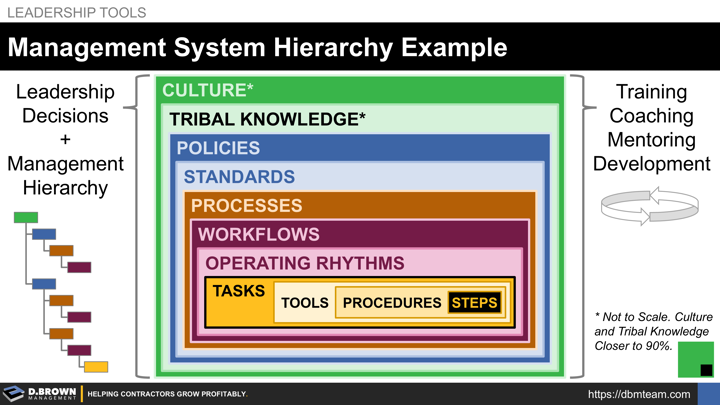A contractor must have both a clear Management Structure and effective Management Systems.
This article is not meant to describe every detail of a management system. Your internal vocabulary may be different and that is OK. There are a few quick prerequisites:
- The diagram is not to scale. Culture and Tribal Knowledge represent closer to 90% of the knowledge in an organization. To think that "everything" must be (or can be) documented is unrealistic. If attempted, it will create stifling bureaucracy. The important aspect is knowing what must be explicitly documented for the stage of growth and phase of management team development.
- All of these, including culture, must be the intentional result of strategic leadership decisions regarding markets, operations, and talent. Allowing them to simply emerge or carry over from previous growth stages due to momentum will impact results.
- They must be integrated with an enabling management hierarchy, evaluation, training, and coaching.
- Understand the 10 Principles for Management System Effectiveness and 4 Phases of Management System Improvement.
Quick Definitions: Hierarchy from Culture to Individual Steps in a Procedure:
Culture: The behavioral norms of an organization, shaped by the key behaviors most rewarded and the non-negotiable boundaries set by the worst behaviors knowingly tolerated by leadership. Culture is the foundational default that fills in the gaps where details are not explicitly defined.
Tribal Knowledge (Tacit Knowledge): The collective intellectual knowledge gained through shared experience and not explicitly documented. Approximately 90% of the world’s information is tacit. This knowledge fills in the gaps within the more detailed and explicitly defined parts of the system, from policies through individual procedural steps. As organizations evolve, there is a continuous effort to convert tacit knowledge into explicit documentation.
Policies: The rules of engagement that clarify intent and define high-level guardrails. Violating a policy must have clearly defined consequences. Policies must incorporate or reference standards.
Standards: Clearly defined expectations, such as how construction documents should be reviewed for estimates or how take-offs should be completed. They establish performance expectations, such as production rates for installation. Standards evolve over time based on frequency of use and impact.
Processes: Start-to-finish guidelines that define the necessary steps to achieve a desired result (standards). A process consists of workflows, tasks, and procedures that work toward a larger objective.
Workflows: The sequential tasks, procedures, responsibilities, and deadlines required for efficient execution of a process, typically represented visually. Example: Plan and spec review workflow.
Operating Rhythms: Setting standard times and calendars for certain tasks, decisions, and information flow within a workflow to synchronize teams across a project and company. This includes standard work and operating rhythms for supervisors and managers.
Tasks: Specific actions or decisions to be completed, each with a single Directly Responsible Individual (DRI). The Level of Detail (LoD) relative to the workflow.
Tools: The resources required to complete a task, including physical tools, equipment, software, forms, checklists, worksheets, etc.
Procedures: Explicit documentation of every step required to complete a task including “tips & tricks” and checklists to ensure consistency.
Steps: The most granular and short-duration element of a procedure. While these may seem insignificant, observation of actual work often reveals a 2X or greater productivity gap between the fastest and slowest 25% of your workforce. Much of this gap can be eliminated through clarity of standards and a little coaching.
Collectively, this forms the Management System, which includes other key components:
- Tools used to complete tasks and individual steps.
- Responsibility Matrices outlining all tasks and specific responsibilities by role, including logical groupings of tasks into roles.
- Job Role Descriptions defining key responsibilities, competencies, and expected outcomes for each role.
- Training Guides and Checklists to support consistent execution.
- Organizational Charts illustrating management and development accountabilities.
Management Systems must be aligned with strategic objectives to create a competitive advantage.

